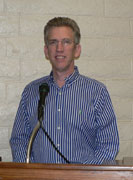South Coast Botanic Garden, by Peter Olpe & Adrienne Nakashima


Peter Olpe, Secretary of the Board of Trustees of the South Coast Botanic Garden, is a software engineer with his own company, specializing in creating apps for electronic devices. He began with a discussion of the local area’s history prior to the establishment of the Botanic Garden.
25 million years ago, the Palos Verdes area was under water and populated with sharks, diatoms and other marine species. The microscopic diatoms, with silica shells, grew in abundance and sank to the bottom after dying, creating a thick layer of diatomaceous earth. By 1.5 million years ago the land began rising into an island (similar to the other Channel Islands). 15,000 years ago the Palos Verdes Island joined the mainland as the Los Angeles basin rose out of the ocean.
In 1542, the first Europeans arrived with Juan Cabrillo of Portugal, who named the future harbor area “Bay of Smokes” (because of campfire smoke in the basin during an inversion layer). In 1602, Sebastian Viscaíno arrived on St. Peter’s feast day and renamed it San Pedro. The Tongva (Gabrieliño) Indians controlled the area until the early 1800s. In 1784, Juan José Dominguez received a 75,000 acre Spanish Land Grant in the South Bay & Long Beach areas, called Rancho de los Palos Verdes; these land grants were provisional, and would revert to the Spanish government if its terms were not satisfied. He allowed the Sepulveda family to use half of this land for cattle grazing.
After 1821, when Mexico won its independence, conflicts arose over who owned the land grants, and the 2 families divided this area, with Sepulveda getting the South Bay area and Dominguez getting the Long Beach area. In 1846, the US declared war on Mexico, and California came under US rule. These 2 families litigated over who owned the South Bay land, but in 1880 Sepulveda, now broke, finally received title to this part of the land. His mortgage broker, Bixby, acquired this land and leased some of it to Japanese farmers.
In 1913, Frank Vanderlip, President of the New York National City Bank, bought 16,000 acres (the Palos Verdes Hills) sight-unseen, to build an exclusive coastal residential property for the wealthy. Then the Dicalite Company began mining diatomaceous earth in northern Palos Verdes. (Palos Verdes has the world’s richest collection of diatomaceous earth, which is used for abrasives and many other purposes; the cliff on Hawthorne Boulevard where it enters Torrance shows an existing example of these deposits.) The Great Lakes Carbon Corp leased 300 acres in 1944, including the site of today’s Botanic Garden, for open pit mining (its president was George Skakel, father of Ethel Kennedy). In 1951, he requested more mining area on the top of the hill. Frank Vanderlip sold 7000 acres to Great Lakes, which then closed its mine and went into real estate development, forming the cities of Palos Verdes Estates, Rolling Hills and Rolling Hills Estates. (The city of Rancho Palos Verdes was formed from the remaining areas of the “Hill” in 1973, to protect the coastline from unlimited development.)
Adrienne Nakashima, the SCBG Foundation’s CEO, began as a high school volunteer at the South Coast Botanic Garden, and worked in nonprofit organizations for years before returning here. She now leads the effort to further develop this beautiful and restorative urban oasis on top of what was once a landfill. She discussed the history of how this beautiful facility was founded.
In 1957 the original mining pit was sold to the County of Los Angeles to use as a trash dump, to reduce smog in the Los Angeles basin from burning trash. In 1959, Frances Young convinced the County to create a botanic garden over the dump, and founded the South Coast Botanic Garden. 3 feet of topsoil was eventually layered on top of 3.5 million tons of trash, which originally produced a large amount of underground heat, methane and ground settling (resulting in the uneven surface now seen in the parking lot and entrance drive). 400 volunteers planted 42,000 plants, and the Los Angeles County Supervisors held a dedication ceremony.
The County owns the land, but the SCBG Foundation runs and operates the facility. Soon a Children’s Garden was formed, a greenhouse was built, a tram was obtained, a lake for ducks was created, and the Hall and Administration Building was constructed. A new tram was obtained in the 1990s, and development has continued with a Rose Garden, Gift Shop, educational programs, Japanese Garden, Discovery Garden, and recently a new electronic marquee at the entrance on Hawthorne Boulevard. Many public events are held on site, and annual memberships are available. More volunteers and donations are needed. New renovations are continuing with a design group developing a 25-year plan, with community participation into its goals. The website is http://southcoastbotanicgarden.org/.